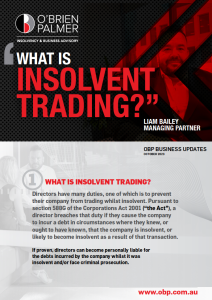And how does it personally relate to you as the Director of the Company?
It’s important for directors to realise that they have a number of obligations and duties when acting as Directors of a company, in particular, how to prevent the company from trading whilst insolvent.
Section 588G of the Corporations Act says that a Director who allows a company to trade whilst insolvent can become personally liable for the debts of the company that have occurred.
DOWNLOAD OUR BUSINESS UPDATE PDF ON UNDERSTANDING
WHAT IS INSOLVENT TRADING, IN YOUR BUSINESS
In our recent video, we talked about recognising the warning signs of insolvency. A company is solvent if and only if, it can pay its debts as and when they fall due and payable. However, determining that a company is solvent is usually an exercise in recognising the warning signs of insolvency. And when enough of them are present at any point in time, Directors have to accept the company is facing serious solvency issues.
The most useful piece of advice for Directors, is to understand how this is going to all be examined, should a Liquidator ultimately be appointed to a company.
Once a Liquidator is applied to a company, we conduct an examination of the books and records of the company to try and determine when the warning signs of insolvency presented in the company, and when these warning signs of insolvency should have been recognised by directors. It’s important to understand that it’s not when did the Director recognise them, but when the Director should have acted competently as a Director.
It’s important for Directors to be realistic and not look at their businesses with rose-coloured glasses – because the people who are making decisions about whether or not you’ve traded the business whilst being insolvent, will not have any of the same biases or prejudices in favour of your business.
A Liquidator will look at the ageing of your debtors and creditors once you’re not paying creditors inside trade terms. We’ll start going through all the books and records to determine a date that the company became insolvent. Do note, that when a company cannot produce the books and records that it requires for a period of time, the company is automatically presumed to be insolvent during that period of time. Therefore failing to maintain or provide the books and records of the company to a Liquidator will only exacerbate the situation of a finding of insolvent trading.
Once the liquidator determines the date on which the company became insolvent, they will also determine which debts the company is subject to, that were incurred after that date. They’ll add those numbers up and that will be the basis for a claim against the director for insolvent training.
The process from this point has the Liquidator issuing a letter of demand to the Director for payment of the amounts owed as an insolvent trading claim, and if this cannot be resolved, Director litigation usually follows.
There are a number of defences that you might be able to make against this claim, and we encourage you to watch this video, or download our helpful fact sheet for more detailed information.
It’s important to note that your responsibility as a Director cannot be abdicated, and Liquidators are bound to act in the best interests of Creditors. If the insolvent trading claim is litigated successfully, it can result in Directors being made bankrupt and their personal assets come into play in respect of their company debts. So it’s always important to take these issues seriously.
If you’re on the receiving end of insolvent trading claim and need some advice, contact O’Brien Palmer. We have a no fee – no obligation policy on the first meeting, and we can discuss how to resolve any of these issues, and possibly make some recommendations for you to obtain the best advice in dealing with these claims.
Unlike my previous videos, which have been a lot more positively focused, solvency is a serious issue facing business. However, it’s not all doom and gloom. There are options to turn your business around so take action today and get in touch with myself or any of the helpful team at O’Brien Palmer to give your business a fighting chance.
Liam Bailey, Managing Partner
O’Brien Palmer
